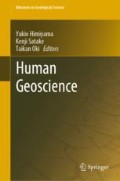Abstract
Regarding to geomorphologic view, the fluvial plain is composed of vulnerable zones against flooding because of different fluvial process and fluvial landforms are categorized for vulnerability risk mapping on the geomorphologic land classification map. Under the land-use change in urban area, transformation of each landform with cutting and filling connotes to be shifted to be a more vulnerable stage in the fluvial plain. In hand with land-use change, social structure for disaster prevention and mitigation has been transfigured to be individualism with nonintervention in local community and indifference in others. The traditional citizen’s participation for mitigation and lifesaving has been bereaved in local community under the natural disaster, however, flood experience and remembering the past evacuation from flooding are precious teaching to suspect or imagine to be lifesaving method and to prepare harmonize community opinions for regional risk communication and risk reduction direction in the local community. It is important for consideration of two dimensions between human dimension and physical dimension to future flood mitigation and prevention.
Access this chapter
Tax calculation will be finalised at checkout
Purchases are for personal use only
References
Hara Y, Haruyama S, Okhubo S and Takeuchi K (2007) Landfill development causes changes in distribution of flood-prone areas: case study in Laguna Plain, Metro Manila The Philippines. In: Hurumai H et al (eds) Southern Asian water environment. IWA Publishing, UK, pp 11–18
Haruyama S (1993) Geomorphology of the central plain of Thailand and its relationship with recent flood conditions. Geo J 26(12):327–334
Haruyama S (1996a) Zoning of flood inundated areas utilizing the geomorphologic land classification map. In: Proceeding of the United State and Japan of Science and Technology workshop on the technology of disaster prevention against local severe storms, pp 185–187
Haruyama S (1996b) The North-South problem in the Flooding in Asia. J Geogr 41(9):71–72 (J). (J) means Japanese
Haruyama S (1997) Geomorphology and flooding in the lower part of U-Tapao River in Southern Thailand. J Gakujyutu Kenkyu (Waseda Univ) 45:1–9 (J). (J) means Japanese
Haruyama S (2002) Tokai torrential rainfall and geomorphological land classification map of the Shonai River Basin. The study, creation and utilization of a geomorphologic land classification map. Kokonshoin in Tokyo, pp 110–114 (J). (J) means Japanese
Haruyama S (2009) Living with flood in Mekong, Kokon-Shoin in Japan (J). (J) means Japanese
Haruyama S eds (2013) Coastal geomorphology and vulnerability of disaster towards disaster risk reduction. TERRAPUB Publisher in Tokyo
Haruyama S, Hayashi K (2013) Tsunami 2004 disaster impacted by recent land use change in Phuket, Thailand. Coastal geomorphology and vulnerability of disaster towards disaster risk reduction. TERRAPUB Publisher in Tokyo, pp 69–86
Haruyama S, Murai A (2004) Geomorphology and flood plain management for flooding mitigation—the lesson from the Kumozu River. J Suiri Kagaku 278:21–32 (J). (J) means Japanese
Haruyama S, Mizuno S (2007) Consideration of disaster feature and local prevention strength under 2004 Fukui flood. J Nat Disaster 26(3):307–322 (J). (J) means Japanese
Haruyama S, Oya M (1987) Comparative study of fluvial plain of Shonai and Yahagi River basins based on geomorphologic land classification. Geog Rev 59(10):571–588 (J). (J) means Japanese
Haruyama S, Simking L (2012) Geomorphology and flooding of the central plain in Thailand at 2011 flooding. J Nat Disaster 30(4):463–476 (J). (J) means Japanese
Haruyama S, Tujimura A (2009) The local prevention activities of the smallest community unit- lesson from 2004 Toyooka flood. E-J GEO 4(1):1–20 (J). (J) means Japanese
Nakano T, Oya M (1960) Relationship between high tide, flooding and landform in Ise bay Typhoon. Geographical Survey Office (J). (J) means Japanese
Oya M, Koike K (1976) Nobi plain fluvial geomorphologic map, upper Kiso river construction office (Ministry of Construction)
Oya M (1956) Geomorphologic land classification map showing flood affected area of the Kiso River Basin_Nobi plain (J). (J) means Japanese
Oya M, Haruyama S (1987) Flooding and urbanization in the lowlands of Tokyo and Vicinity. J Nat Disaster Sci 9(2):1–12
Shonai river construction office (1957) https://www.cbr.mlit.go.jp/shonai/origawa/familia/saigaishi/index.html (J). (J) means Japanese
Taresawa Y, Haruyama S (2013) Coastal landform in the southern part of Miyagi Prefecture and 2011 Tsunami disaster. Coastal geomorphology and vulnerability of disaster towards disaster risk reduction. TERRAPUB Publisher in Tokyo, pp 87–96
Yoshida A (2013) The evaluation of the flooding in the Shonai River Basin and future measures. The Graduate thesis of Mie University (J). (J) means Japanese
Author information
Authors and Affiliations
Corresponding author
Editor information
Editors and Affiliations
Rights and permissions
Copyright information
© 2020 Springer Nature Singapore Pte Ltd.
About this chapter
Cite this chapter
Haruyama, S. (2020). Land-Use Change and Flood Risk Transformation in Urban Area. In: Himiyama, Y., Satake, K., Oki, T. (eds) Human Geoscience. Advances in Geological Science. Springer, Singapore. https://doi.org/10.1007/978-981-32-9224-6_15
Download citation
DOI: https://doi.org/10.1007/978-981-32-9224-6_15
Published:
Publisher Name: Springer, Singapore
Print ISBN: 978-981-32-9223-9
Online ISBN: 978-981-32-9224-6
eBook Packages: Earth and Environmental ScienceEarth and Environmental Science (R0)

